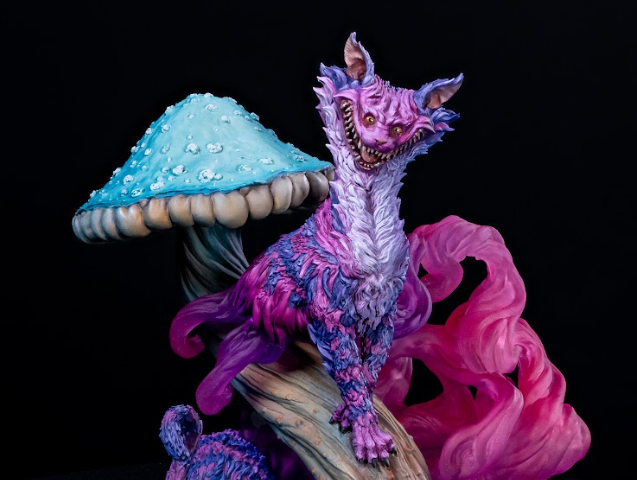Speed Painting Miniatures
Less Effort, Same Quality

Let’s be real—painting miniatures is awesome, but it can also eat up a lot of time. If you’ve ever spent hours on a single model only to realize you’ve got a whole army left to go, you know exactly what we’re talking about. That’s where speed painting comes in.
Speed painting isn’t about being sloppy. It’s about being smart. It’s about getting your miniatures to look great fast, so you can spend less time hunched over your painting table and more time rolling dice, telling stories, and crushing your enemies on the battlefield.
In this guide, we’re going to break down some of the most effective speed painting techniques out there. Whether you’re new to the hobby or just want to crank out an army without sacrificing quality, these tips are here to help.
Why Speed Painting?
Painting miniatures can be one of the most rewarding parts of the hobby. But not everyone has hours to spare for each model. If you need to paint a full army of orcs before your next game night or even clear your pile of unpainted shame, then speed painting is your best friend now.
Plus, there’s something satisfying about seeing a whole squad come together quickly without getting bogged down in the details.
Key Techniques for Speed Painting Miniatures
Let’s jump into some battle-tested techniques that can save you serious time while still delivering great-looking results. And if you are a more visual type of learner, we got you covered with some video tutorials in each paragraph as well.
1. Dry Brushing
Dry brushing is one of the oldest and most trusted speed painting techniques out there. It’s super simple, fast, and adds instant depth and highlights to your mini.
How it works:
- Load a brush with a small amount of paint;
- Wipe most of it off on a paper towel;
- Lightly drag the brush across raised surfaces of the miniature.
Dry brushing works especially well on textures like fur, chain mail, or rocky bases. It gives you quick highlights with almost no effort. Pair it with a dark base coat and boom—instant depth.
2. Slap Chop
Slap Chop is the new kid on the block, but it’s quickly become a favorite for painters looking to balance speed and style.
How it works:
- Prime your mini black;
- Dry brush with gray (or even white) to create a value sketch;
- Apply thin contrast or speed paints over the light part.
The result? You get shadows, mid-tones, and highlights in a single pass. It’s fast, it looks great, and it gives your minis that gritty, high-contrast look that’s perfect for fantasy and sci-fi games.
3. Zenithal Priming
Zenithal Priming is a fancy term for a pretty straightforward concept: using light to guide your paint job.
How it works:
- Start with a black primer;
- Spray white or gray primer from above the mini, like a spotlight.
This gives you instant light and shadow on the model. You can stop here and go straight to washes or contrast paints, or use it as a guide for more detailed work.
Zenithal priming really helps you cheat the lighting and make your minis pop with minimal effort. It can be done either with airbrushes or regular ones (with dry brush).
4. Batch Painting
Painting one mini at a time? That’s fine for characters and centerpieces. But if you’ve got a hundred goblins — like our friend in this video—, batch painting is the way to go.
Here’s the basic idea:
- Paint all your bases at once;
- Then all your armor;
- Then all the weapons;
- Then all the details. Etc.
The idea is to do the painting step by step in all minis, rather than focusing on all the steps in a single one. Might feel repetitive, but it’s incredibly efficient. You get into a rhythm, and your brain starts working on autopilot. With an airbrush you’ll finish a lot faster, but if you don’t have one, it’s ok, it works with regular brushes as well.
5. Use Bigger Brushes Than You Think
Sounds obvious, but many painters get stuck using tiny detail brushes for the whole process. Speed painting is all about coverage. Don’t be afraid to use a medium or even large brush for base coating and dry brushing.
Pro tip: A size 2 round brush is perfect for most details. You don’t need a size 000 brush unless you’re painting eyes (and let’s be honest—you probably don’t need to paint those at all). We talked more about brushes in this text here.
A Few Extra Tips
- Limit your color palette: Fewer colors = faster decisions = faster painting;
- Work from dark to light: Start with shadows and work your way up;
- Don’t obsess over perfection: These are gaming pieces, not display pieces (unless you want them to be, then this is an entire other conversation);
Keep your workspace organized: Less time looking for your brush means more time painting.
Final Thoughts
Speed painting isn’t about cutting corners—it’s about knowing where to focus your time and effort. With a few clever techniques, you can get your miniatures looking amazing in a fraction of the time.
And here’s the best part: once your minis are painted, you actually get to use them. In your games. On your table. Telling stories and creating moments with your friends. Lovely.
So the next time you’re staring at a mountain of gray plastic, don’t panic. Grab your dry brush, prime smart, and slap some paint on there. You’ve got this.
And hey—if you’re looking for incredible STL files to print and paint, you already know where to go. We got your back with insanely detailed minis that look great even when painted fast.
Happy painting!
Loot Studios can help you paint highly detailed minis, statues and props. Choose your favorite bundle from our previous releases or sign up for Fantasy or Sci-Fi to receive a new bundle every month. You can also check out some tips at our YouTube Channel.




